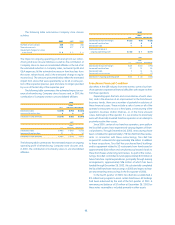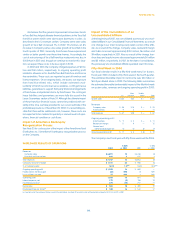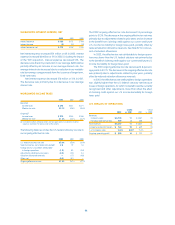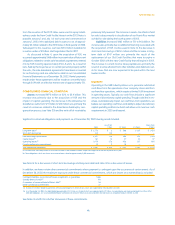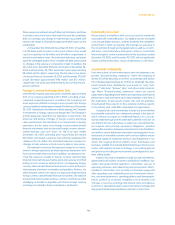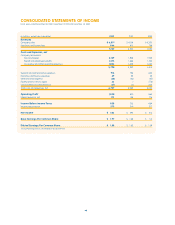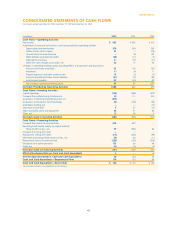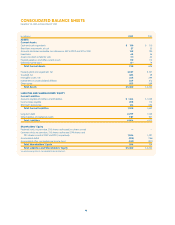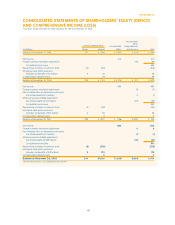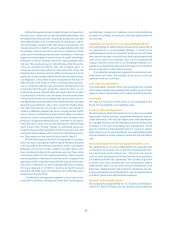Pizza Hut 2002 Annual Report Download - page 44
Download and view the complete annual report
Please find page 44 of the 2002 Pizza Hut annual report below. You can navigate through the pages in the report by either clicking on the pages listed below, or by using the keyword search tool below to find specific information within the annual report.
OTHER SIGNIFICANT KNOWN EVENTS, TRENDS OR
UNCERTAINTIES EXPECTED TO IMPACT 2003
OPERATING PROFIT COMPARISONS WITH 2002
New Accounting Pronouncements
See Note 2.
Pension Plan Funded Status
Certain of our employees are covered under noncontributory
defined benefit pension plans. The most significant of these plans
was amended in 2001 such that employees hired after September
30, 2001 are no longer eligible to participate. As of our September
30, 2002 measurement date, these plans had a projected bene-
fit obligation (“PBO”) of $501 million, an accumulated benefit
obligation (“ABO”) of $448 million and a fair value of plan assets of
$251 million. Subsequent to the measurement date but prior to
December 28, 2002, we made an additional $25 million contri-
bution to the plans which is not included in this fair value of plan
assets. As a result of the $250 million underfunded status of the
plans relative to the PBO at September 30, 2002, we have
recorded a $71 million charge to shareholders’ equity (net of tax of
$43 million) as of December 28, 2002.
The PBO and ABO reflect the actuarial present value of all
benefits earned to date by employees. The PBO incorporates
assumptions as to future compensation levels while the ABO
reflects only current compensation levels. Due to the relatively long
time frame over which benefits earned to date are expected to be
paid, our PBO and ABO are highly sensitive to changes in discount
rates. We measured our PBO and ABO using a discount rate of
6.85% at September 30, 2002. A 50 basis point increase in this
discount rate would have decreased our PBO by approximately
$49 million at September 30, 2002. Conversely, a 50 basis point
decrease in this discount rate would have increased our PBO by
approximately $56 million at September 30, 2002.
Due to recent stock market declines, our pension plan assets
have experienced losses in value in 2002 and 2001 totaling
approximately $75 million. We changed our expected long-term
rate of return on plan assets from 10% to 8.5% for the determina-
tion of our 2002 expense. We believe that this assumption is
appropriate given the composition of our plan assets and histor-
ical market returns thereon. This change resulted in the recognition
of approximately $5 million in incremental expense in compari-
son to 2001. We will continue to use the 8.5% expected rate of
return on plan assets assumption for the determination of pension
expense in 2003. Given no change to the market-related value of
our plan assets as of September 30, 2002, a one percentage point
increase or decrease in our expected rate of return on plan assets
assumption would decrease or increase, respectively, our pension
plan expense by approximately $3 million.
The losses our plan assets have experienced, along with the
decrease in discount rates, have largely contributed to the unrec-
ognized actuarial loss of $169 million in our plans as of September
30, 2002. For purposes of determining 2002 expense our funded
status was such that we recognized $1 million of unrecognized
actuarial loss in 2002. We will recognize approximately $7 million
of unrecognized actuarial loss in 2003. Given no change to the
assumptions at our September 30, 2002 measurement date, actu-
arial loss recognition will increase gradually over the next few
years, however, we do not believe the increase will materially
impact our results of operations.
In total, we expect pension expense to increase approxi-
mately $14 million to $41 million in 2003. We have incorporated
this incremental expense into our operating plans and outlook.
The increase is driven by an increase in interest cost because of
the higher PBO and the recognition of actuarial losses as dis-
cussed in the preceding paragraph. Service cost will also increase
as a result of the lower discount rate, though as previously men-
tioned the plans are closed to new participants. A 50 basis point
change in our discount rate assumption of 6.85% at September
30, 2002 would impact our pension expense by approximately
$11 million.
We do not believe that the underfunded status of the pension
plans will materially affect our financial position or cash flows in
2003 or future years. Given current funding levels and discount
rates we would anticipate making contributions to fully fund the
pension plans over the course of the next five years. We believe
our cash flows from operating activities of approximately $1 billion
per year are sufficient to allow us to make necessary contributions
to the plans, and anticipated fundings have been incorporated
into our cash flow projections. We have included known and
expected increases in our pension expense as well as future
expected plan contributions in our operating plans and outlook.
QUANTITATIVE AND QUALITATIVE DISCLOSURES
ABOUT MARKET RISK
The Company is exposed to financial market risks associated with
interest rates, foreign currency exchange rates and commodity
prices. In the normal course of business and in accordance with
our policies, we manage these risks through a variety of strate-
gies, which may include the use of derivative financial and
commodity instruments to hedge our underlying exposures. Our
policies prohibit the use of derivative instruments for trading pur-
poses, and we have procedures in place to monitor and control
their use.
Interest Rate Risk
We have a significant market risk exposure to changes in interest
rates, principally in the United States. We attempt to minimize this
risk and lower our overall borrowing costs through the utilization
of derivative financial instruments, primarily interest rate swaps.
42.


